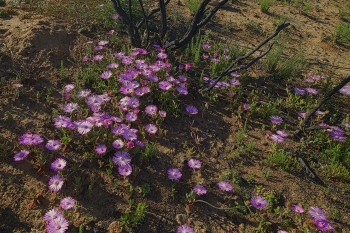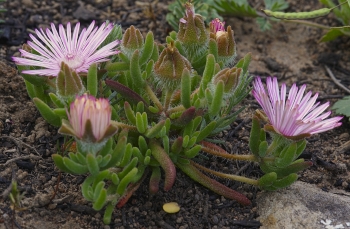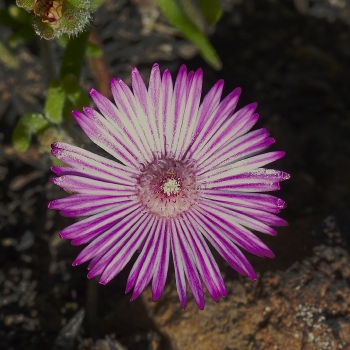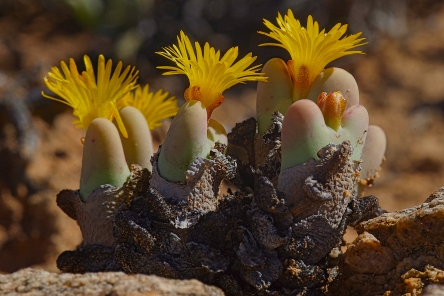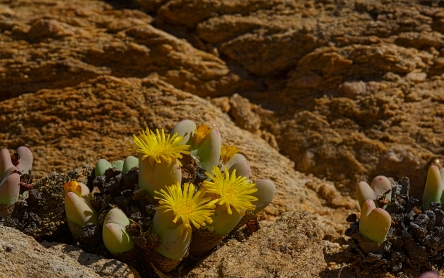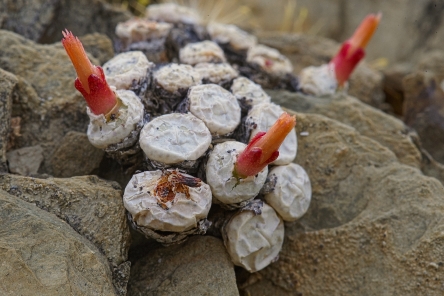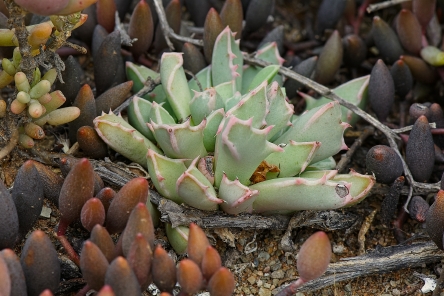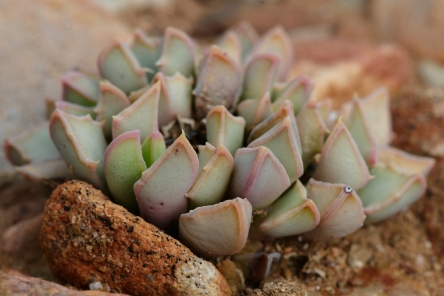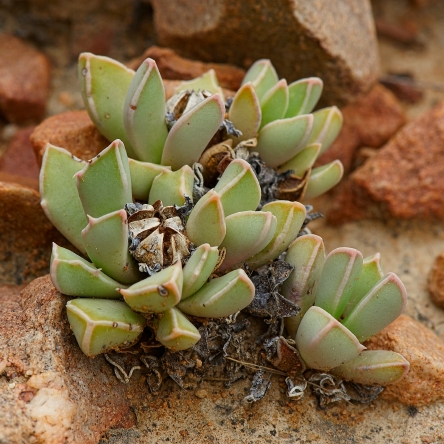Conophytum bilobum ssp. bilobum, 1st April 2012.
Look at the reptile-like remains of old leaves in the first picture.
Tag: Mesembs
Conophytum joubertii
Faucaria bosscheana
Machairophyllums flowering after fire
In an earlier post I referred to a fire that raged on the nearby Rooiberg about a year ago.
Approximately half a year after the fire we discovered a great number of flowering Machairophyllums in the burnt areas.
Although there are several populations on the Rooiberg, we had never found a flowering specimen before and we wondered why that was. Had we never been there in the right time of the year and of the day (the flowers open after dark) or did the plants, like so many others occurring in fynbos, need a fire to trigger flowering?
Last Sunday we decided to visit the mountain again and see if we could find out if the Machairophyllums in the not burned areas had flowered so profusely last year as well. This is easy to establish because the fruits stay on the plants for a long time. We saw a couple of hundred plants in perfect condition, but only very few with (max. 2-3) fruits. If you look at the accompanying pictures (taken last October), you will see how profusely the plants flower after a fire.
All in all It seems safe to say that this species of Machairophyllum -and probably the others too- may not be totally dependent on fire to trigger flowering, but that it certainly makes an enormous difference.
When I say “this species of Machairophyllum “ you probably wonder exactly what species we are talking about here. Comparing all the information from literature, I come to the conclusion it is most probably M. albidum. Apparently other people too have a problem deciding which is which in this genus: The Illustrated Handbook of Succulent Plants recognises 7 species but also says “The genus is under study and four or five species may only be distinguishable”.

This picture was taken at 6.32 PM, when there was still just enough light to use
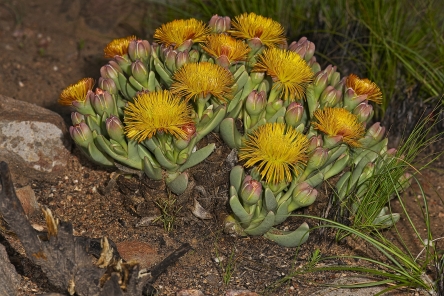
Fifteen minutes later the light had gone. so I had to use flash for this and the next two pictures
An unexpected pleasure (Drosanthemum striatum)
A few weeks ago my friend George Hattingh, who is about as mad about succulents as I am, told me that he had seen some beautiful succulents in flower which he could not identify. They were growing on top of the Rooiberg, a little mountain range just South of Calitzdorp which you have to cross on the way to Vanwyksdorp. As the road meanders its way up, it takes you through different vegetation zones. At the lower slopes a lot of succulents are found, whereas the plateau with its moister and colder climate is covered in arid fynbos. In winter and early spring the fynbos is at its best, with many different plant in flower. This type of vegetation harbours only few succulents, but some of the ones that do grow there are rather interesting. One of the plants George had found is probably an Antimima, but these I often find difficult to name. All suggestions are welcome.
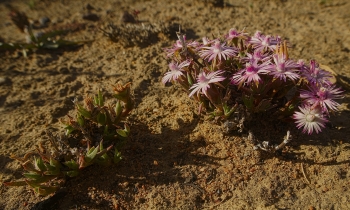
The other species was clearly a Drosanthemum, but which one? After going through the literature, the only species of which the description fitted was D. striatum. According to the “Red List of South African Plants” (2009) this is a vulnerable species with only 10 locations remaining after much its habitat has been transformed for wheat and vineyard cultivation. The distribution range is given as: Malmesbury and Worcester to Swellendam and Bredasdorp. This is well outside the Calitzdorp area (even the nearest of these places is at least a 100 kms away). This new find means that the species has a rather wider distribution than assumed; hopefully it also means that it is less vulnerable than thought.
The peculiar thing is that we never found the plants before. The most likely explanation is that -like many other fynbos plants- they only flowers after fire. Or maybe we just missed them because they were too well hidden by all the vegetation that is normally present. Even without flowers they would have been much more visible without all kinds of other plants hiding them. At this moment (about seven months after a big fire on the mountain) large patches are still almost bare, so anything colourful stands out.
Whatever the reason, it just shows that interesting botanical discoveries can still be found in this part of the world.
